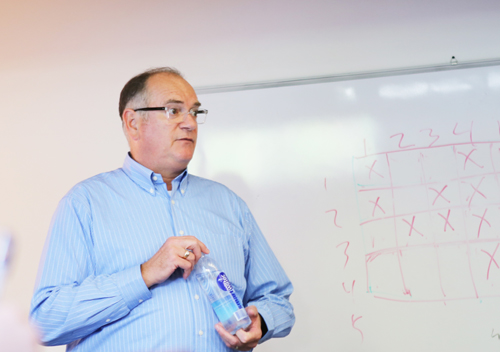
from USA vol. 71 2015.06.17 Portland rises from the ashes of economic recession. What are the secrets of this beloved futuristic city?
![]()
- Overcoming 2 historic economic crises
- Having roots in Oregon
- Post oil shock transformation
- Innovative town organizations change the city
- A love for food and agriculture and a challenging spirit
- The carpet pattern everyone remembers
- A new future brought to life by shared values - living in harmony with nature
Are you familiar with the concept or the vision of the town that you live in? Or do you remember the design of the carpet in the airport closest to you? The people of Portland, Oregon, in the United States can answer "YES!" to both these questions.
Portland is currently developing at an amazing speed. This city with a population of only 600,000 people is welcoming countless visitors from all around the U.S. and the globe, and more than 350 people are moving in each week. New shops also open every week and innovative trends are born weekly, too. Some people think of Portland as the city of the future. But when you look about the city, it appears neither high-tech nor bright and shiny.
So why is such a small, rural city drawing so much global attention? What makes it seem so futuristic? Let us explore the answers to these questions as I introduce the city's history, what I've learned about the city over the past few years, as well as an interview with my friend Bob Hastings, who is an architect and urban planner residing in Portland.
(text by Yuhki Udagawa)
目次へ移動 Overcoming 2 historic economic crises
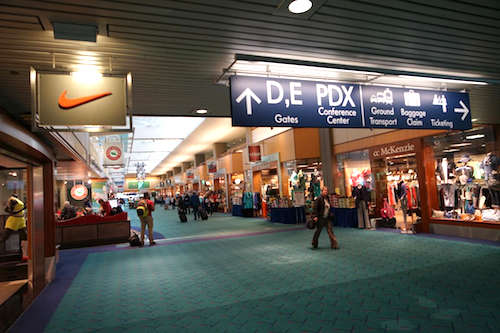 Portland International Airport chosen as America's best airport by Travel + Leisure Magazine.
Portland International Airport chosen as America's best airport by Travel + Leisure Magazine.
Two historic economic crises -the oil shock of the 1970s and The Great Recession in 2008 - have actually helped spur Portland's continuous growth. The 2 crises are not similar, rather, the changes Portland underwent after the 70s helped transform The Great Recession into newfound momentum 40 years later.
Many people in the U.S. were financially impacted by The Great Recession in 2008, triggering them to reexamine their values. Are we happier because we make more money? Is our happiness defined by better houses, better cars? Or by continuing to compete with one another?
People began to think about the fundamentals - a healthy lifestyle, a fulfilling way to spend time, meals that are not extravagant, yet delicious nonetheless. Eventually, Portland, a suburban city with many citizens that feel this way, began to draw attention. What generated interest was actually a comedy TV program? "Portlandia," a TV show that pokes fun at Portland's unique values and lifestyle, began airing in 2011. The city's popularity rapidly increased thanks to this satirical sketch comedy.
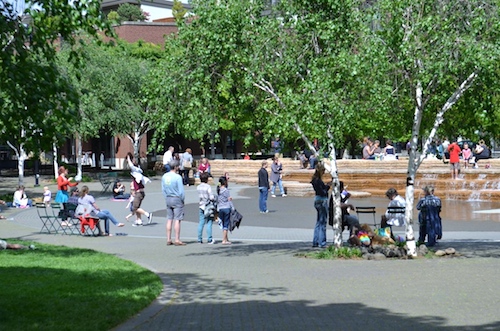 People from different generations gather around the fountain in Jamison Square.
People from different generations gather around the fountain in Jamison Square.
In 2013, Portland's unique culture and lifestyle also began to draw attention in Japan, leading to the publication of guidebooks on Portland's hipster culture, special features in major magazines, and the publication of the Japanese version of "KINFOLK," a magazine that has roots in Portland. And today, Portland has become a popular tourist destination. It's probably the first suburban city ever to become popular in Japan.
The city is also popular in other East Asian countries like Taiwan and Korea as well as in Europe, but it is especially popular among the Japanese. This may be due to the Great East Japan Earthquake that struck Japan in 2011. Like the Lehman shock in the U.S., this earthquake sparked a revolution of values, prompting many people in Japan to reexamine their values. Portland's example seems to better fit the Japanese people's lifestyle, and so the city has become more popular here than in any other country. I'm sure many Think Daily readers have either visited or have friends or acquaintances who have visited Portland.
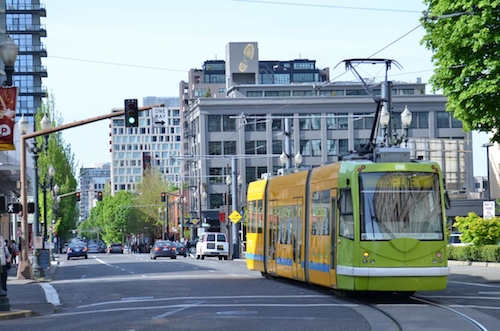 Trams that cover the key areas of Portland.
Trams that cover the key areas of Portland.
When people think of Portland, they may think of hipsters with tattoos and long beards, cute shops and hotels, and great coffee and beer. Of course this is all true, however, for example, hipsters only live in certain parts of town, and they only account for 2-3% of the city's population. Actually, there is a large elderly population, and you will find many seasoned shops that you might see in old movies rather than new shops.
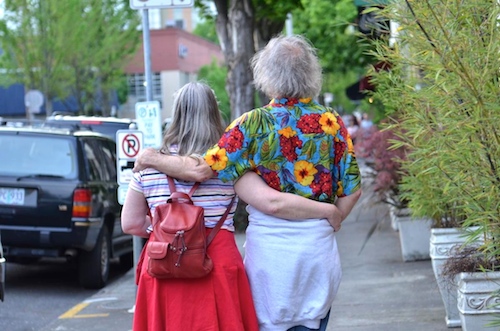
Although Portland is a wellspring of new, "rad" culture, somehow it has also preserved the old. The city attracts young fashion designers and creators, but it is also popular among the elderly. This seems somewhat contradictory, but what makes it so popular to different generations of people?
We won't discover the reasons why if we don't dig deeper than the surface, and we can't just look at Portland as a just "city." The citizens know what the city's concept is; they remember what the old carpet in the airport looked like. And how has the city come back from 2 historical crises? What is the key to its resilience?
目次へ移動 Having roots in Oregon
The secret lies in "Oregon's vast wilderness."
What do I mean by this? To better explain this to you, I interviewed an older and wiser friend, Bob Hastings, who is an architect and urban planner, about the city and its architecture.
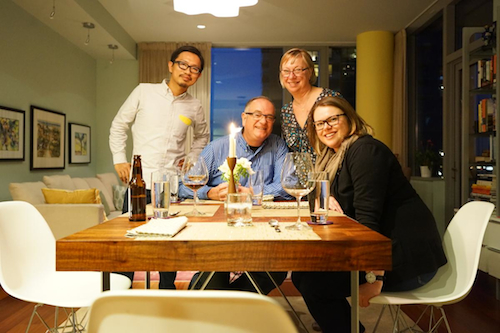 Bob, his family, and myself.
Bob, his family, and myself.
I met Bob at the "Eco District Summit," which is a conference that attracts sustainable urban planners from all around the world. He was born in Los Angeles, California, and moved to Oregon to study architecture at the University of Oregon. Thereafter, he attended graduate school at University of Pennsylvania and then moved back to Portland to join one of the largest architectural, urban planning firms in the U.S., ZGF Architects LLP. He then joined TriMet, a company that operates Portland's public transportation. He has 2 children with his wife, whom he met in university. His daughter now works as an architect at ZGF, so the Hastings are a family of architects.
As the nation's name indicates, being a union of states the American people's sense of belonging to their home state is quite pronounced.Laws differ from state to state, too, so once you cross into another state, it's like being in another country. People do really feel a strong connection with their home state, hometown.
"Oregon's values come from an appreciation of the beauty of its natural environment. We take our relationship to nature very seriously, but not ourselves. While all Americans have a strong sense of pride in their state, Oregonians have a more, 'We're willing to try anything that we think will make our place a great place to live and thrive.'" (Bob)
Many people seem to feel the same way. Someone told me this joke, "Of all the Puritans who came from Europe, people who were dazzled by gold (or the Gold Rush) passed through Oregon and made their way to California. People who were dazzled by nature settled in Oregon."
This joke is not necessarily cynical; every state makes jokes about its neighbors. Oregon seems to be quite competitive with California, its neighbor to the south, which is industrially rich. But often times, states do not compete on the same scale, rather they seem to think, "They might have this, but we have this!"
Let's take a closer look at Oregon's nature, which said to be more dazzling than gold.
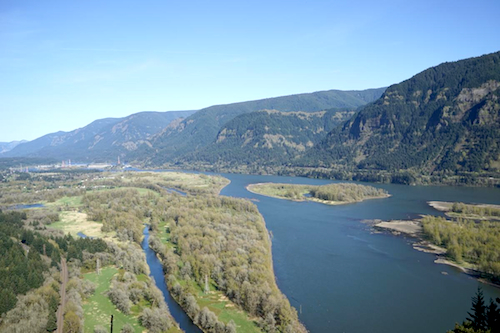 The Columbia River basin.
The Columbia River basin.
When you drive 30 minutes out of Portland, this is the scenery you'll see. Lowland farms stretch to the horizon.
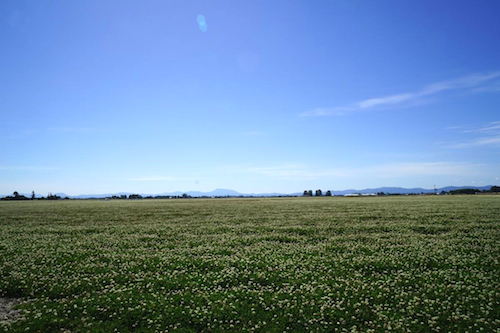 Apiary.
Apiary.
It is truly beautiful! I also love Oregon's wilderness so as soon as I land at the airport, I often head in the opposite direction of the city, and take a deep breath before heading into work. But the U.S. is extremely vast and spacious and many other states are richly endowed by nature. So why are the people of Portland more aware of nature around than most?
目次へ移動 Post oil shock transformation
Portland is also famous for being one of the few "Walkable Cities" in the U.S., but until the oil shock of the 70s, people couldn't get around without cars, so it was just like any other city in the U.S. And like many other cities, Portland's city center had begun to hollow out.
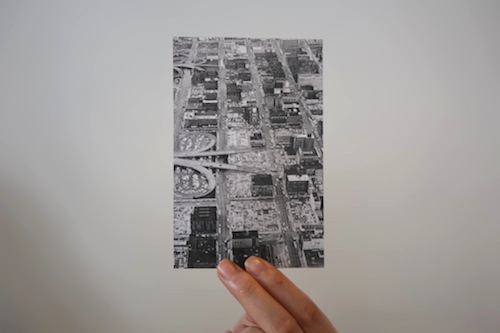 The city center of Portland before the oil shock.
The city center of Portland before the oil shock.
There were many parking lots in the city center, and because there weren't many people walking about it wasn't very safe. Things changed drastically after the oil shock. As a result of a campaign led by citizens, who began to wonder why they couldn't live without cars, parking lots were transformed into plazas, work on highways that were under construction was stopped, and roads alongside rivers became parks. And by making public transportation mainly developed around trams, Portland started to become a pedestrian-centric city. Why was it able to make such a transformation so quickly? This, too, was due to the unique Oregonian spirit.
"Since the coming of European/American peoples, there's been an overpowering desire to command nature for the wealth it can provide. Fish have been over harvested, timber has been overcut, and the industrial age accelerated the reaping of nature's bounty and degradation of the air, soil, and water.
But Oregon was one of the first states to recognize that strong measures needed to be adopted if its natural beauty was to survive for future generations. Oregon citizens led this change through ballot measures, changing its elected leadership, adopting innovations in governance. Central to this ethos was the belief that when the most vulnerable were provided for, then the whole of Oregon society benefitted. Tangible examples of this ethic are the protection of the state's entire coastline for use by all Oregonians, adoption of the first bottle bill to reduce pollution, and creation of land use policies to protect farm and forest lands." said Bob.
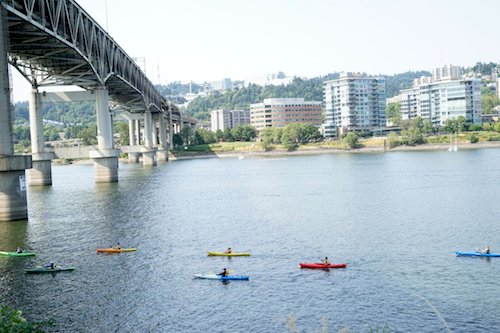 Decades of effort to clean water have born fruit. Today, residents can enjoy water sports.
Decades of effort to clean water have born fruit. Today, residents can enjoy water sports.
What has notably contributed to the city's development is the Urban Growth Boundary (UGB). This planning law controls the use of land for urban development. Areas inside the boundary can be used for higher density development while the area outside is protected as agricultural, rural land. If you go to the edge of the UGB, the boundary is clear as day.
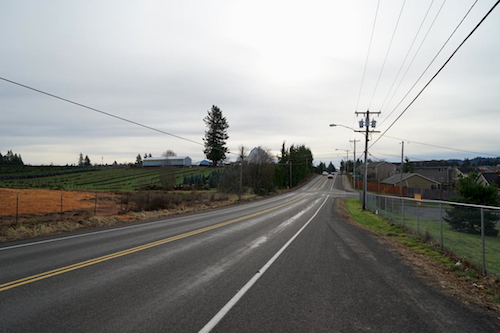 UGB. The left side of the road and beyond is agricultural land, and on the right is the residential zone.
UGB. The left side of the road and beyond is agricultural land, and on the right is the residential zone.
I've described the tangible benefits, but what other benefits has it given way to?
"Three things - forest and farmland are held in the highest regard for both the importance of natural environmental systems and the benefits of well managed agriculture.
Citizens, governance, and private industry have to work together to create a thriving, sustainable economy that serves sustainable communities. The outcome of this, while very challenging, is a more engaged and educated citizenry."
Firstly, with the wilderness and farms close by, citizens developed newfound respect for them. With respect to the second and third benefits, because of the UGB, there are clear community units that require close cooperation between the government, industry, and citizens for the development of high-density areas and fertile lands.
The UGB is not a viable policy for all cities. The UGB was only implementable and it only worked so well because Portland's citizens loved nature, and helped transform the oil shock and the hollowing out effect into a great opportunity.
I mentioned in the beginning that people of Portland know what the city's concept is, but this is also due to the implementation of UGB. When people of Portland talk about their hometown and what is better about it in comparison to other cities, they often talk about how accessible the rivers and forests are. Because they have kept the towns small, they have managed to keep the wilderness nearby.
The third benefit - educated citizens who are more proactive and open to participation - that Bob mentioned is also unique to Portland. This is what impressed me the most when I first visited this city. The decision-making process of Portland's government mainly involves the chair and 4 representatives.
So what do the other representatives do? Actually, there are only 4 representatives, who are called city commissioners.
This compact assembly is open to citizen participation, so anyone can take part and share their views. And it is the neighborhood associations that consolidate and streamline citizens' views.
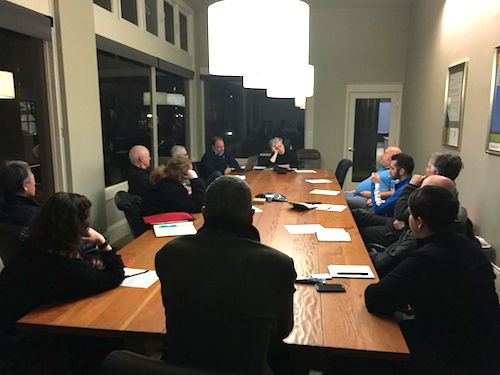 Pearl District Neighborhood Association deliberating on a particularly difficult subject.
Pearl District Neighborhood Association deliberating on a particularly difficult subject.
目次へ移動 Innovative town organizations change the city
Ever since I first learned about the neighborhood association in the book, "GREEN Neighborhood" (written by Ryohei Suita, published by The Senken Shimbun Company), a pioneering book that categorically introduced how the city of Portland has developed to people in Japan, I have been interested in neighborhood associations. I wanted to contact them during my first visit, so I looked one up and saw that all the assembly dates were publicized, and anyone could take part. I sent them an e-mail just to be sure, and I received a very welcoming response. This became the launch pad for my deep involvement with Portland.
When I went to a meeting, I saw young people speaking to an elderly lady who has lived in the city for a long time. It was the first time that someone from Japan had visited the neighborhood association. They answered all my questions and the elderly lady even gave me a reading assignment so that I could better understand where they are coming from.
What is unique about Portland's development is how active these neighborhood associations are. The city has 95 "neighborhoods," each with their own neighborhood association. How active neighborhood associations are differ depending on the neighborhood. A relatively new neighborhood with a very active neighborhood association, the Pearl District organizes committee/subcommittee meetings each week. Nowadays they receive visitors from Japan who are involved in city planning once every 2 weeks.
What make the sessions unique are the open and frank discussions. They talk about a wide range of subjects from town festivals, the color of paint of the exterior walls of the new complex being built, to new shops that may be moving into the empty roadside boutiques. They also invite developers and other companies to take part. Let's say that a organic supermarket with close ties to the community wants to open a new store. Its representatives will take part in these meetings from 6 months prior to the grand opening to get feedback from the people of the community. They will discuss what hours the shop should be open, what kind of products it should carry. Hats off to the open-mindedness of these people who welcome and offer feedback.
Now let's get back to Bob. What makes people love their own land and their community so much?
"Maybe it's the rainy weather, strong coffee, or shared sense of place."
Many foreigners think of sunny weather when they think about the west coast, but actually the northwest has a long rainy season that lasts from October to April. The rains are not like the guerilla rains in Asia. The rainy season in the northwest entails cloudy skies and misty, off-again, on-again drizzle. It hardly snows, but people here end up spending a lot of time in the wilderness or indoors. "Strong coffee" is a Portlandian joke. When trying to explain why there are many Portlandians who are lifestyle conscious, they often say something like "We have a heightened sensitivity because we've been drinking too much good coffee" or "We come up with strange ideas because we have great tasting beer, and we drink too much of it."
Heightened sensitivity is closely linked to the long rainy season and strong coffee. Like northern Europe, people end up spending a lot of time indoors, so many shops and hotels have been elaborately designed, and many people also spend a lot of time on home decor. This is also apparent in the cityscape.
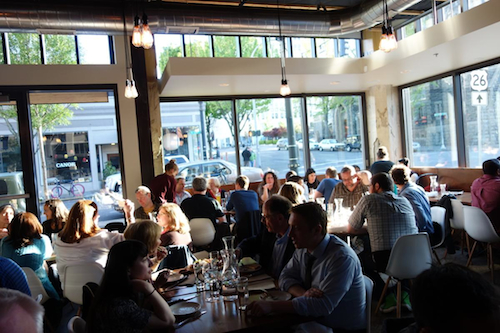 Tasty n Alder, a popular restaurant in Portland.
Tasty n Alder, a popular restaurant in Portland.
The first floor of all buildings in the city center must be made available for shops and restaurants, and most stores use transparent material, in other words glass, on the stores' facade. This is the case so that even if there are many people indoors, the town will still seem lively and energetic.
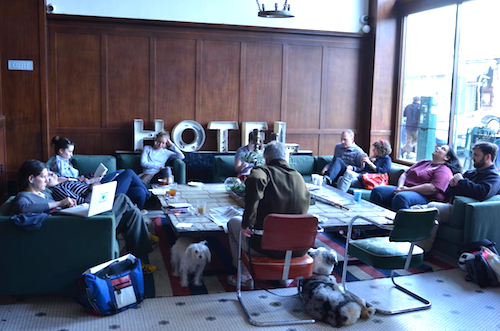
When people talk about Portland, they often mention the Ace Hotel, but this hotel, too, also reflects this characteristic. There are Ace Hotels in cities such as New York, Los Angeles, and Seattle, but what makes the one in Portland unique is the glass-covered lobby on the first floor. Usually, as soon as you enter boutique hotels in U.S. cities you'll see the reception desk, but in the Ace Hotel in Portland, the reception desk is at the back of the building and people can look in on the spacious lobby from the outside. As a result, this space has become a relaxing space for travelers and residents alike, and it also adds to the energetic atmosphere of the city.
目次へ移動 A love for food and agriculture and a challenging mind
When talking about Oregon's values, we have to talk about food and agriculture.
According to Bob, "Once Oregonians realized that they needed to stop destroying the very thing that would support them...they've eagerly sought ways to create a healthy, vibrant, and sustainable economy. It's not surprising to see 'homegrown' products and flavors have blossomed in this natural and cultural environment - from Oregon's wine industry, to craft beers, to food products like Dave's Killer Bread! The raw food materials and how they're made into high quality cuisine has created important relationships with growers and chefs and creating bridges between rural and urban Oregonians.
Oregon's most enduring industry is agriculture and the almost mythical belief that its local farm products are the highest quality in the world. The incredible diversity of unique environments and the willingness to try new ideas has spawned a cultural value to seek the freshest, highest quality and most interesting food and cuisine."
Traditionally, the cuisine in Oregon tends to highlight the natural flavors of the produce that comes from the land they love so much. For example, at Bob's house -
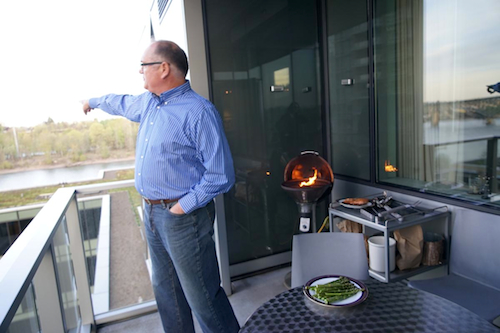 Men in Oregon typically like to grill food on their verandas.
Men in Oregon typically like to grill food on their verandas.
On the day of my visit, he grilled salmon and asparagus, which are local specialties. This compact BBQ grill can be found on the verandas of most homes, even apartment buildings. In general, people in Oregon like to lightly grill seasonal foods and enjoy the natural flavors.
On the other hand, the enthusiasm with which people come up with new recipes for bringing the produce to life has helped create the movement we are witnessing today in Oregon. This is taking place in the restaurants and on the farms. Let's take a look at a few examples.
Let's start with a very popular restaurant, which continues to have a long waiting list, "Tasty n Alder." I had the most memorable dish there in years.
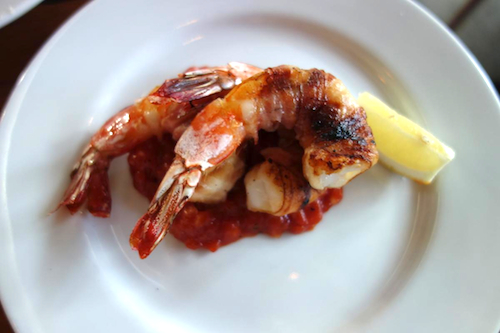
Grilled shrimp?
It is actually grilled shrimp wrapped in bacon. You can probably guess what it tastes like. It disappeared from the menu shortly afterwards.
Of course, some challenges are successful. For example, craft beer is becoming very popular even in Japan. Oregon is the first state in the U.S. that allowed businesses to run a bar at the brewery, so there are over 50 microbreweries just in the city of Portland. IPA, which uses locally produced hop in abundance, is quite famous. Hard cider, also created by locally produced apples, is also gaining popularity. Unlike beer, there hard cider didn't really have a market, but over the past decade, demand has multiplied rapidly.
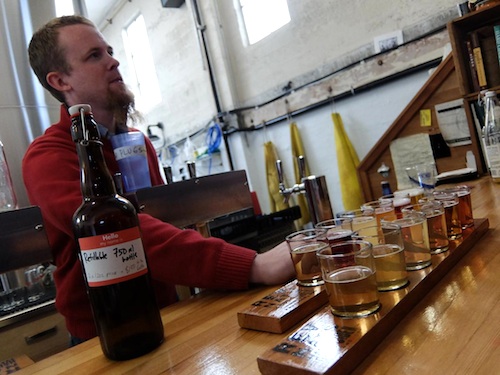 The owner of Reverend Nat's Hard Cider, Nat.
The owner of Reverend Nat's Hard Cider, Nat.
This is all hard cider. Reverend Nat's Hard Cider, a cidery (hard cider breweries) that has drawn attention for its challenging spirit creates over 10 flavors of hard cider. Oregon's hard cider is taking a giant leap forward by using hop, a production method unthinkable in Europe.
The owner of Reverend Nat's Hard Cider, Nat has conducted many unique experiments over the past 8 years, and now he even exports his cider abroad. Next, let's take a look at what kind of challenges apple farmers are undertaking.
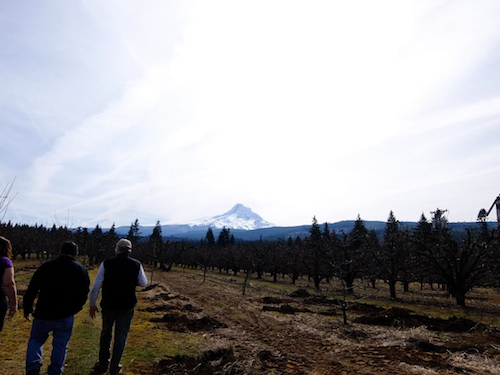 The apple orchard located at the foot of Oregon's symbol, Mount Hood.
The apple orchard located at the foot of Oregon's symbol, Mount Hood.
I went after the harvest, so the trees look a little bare, but the apple farmers in Oregon work on an extremely large plot of land. It's not just about quantity. They also work hard to improve quality and efficiency. A lot of trial and error is involved to get the right balance. They have continued with their research and tested new cultivation methods. And since the hard cider market has begun to stabilized they have begun creating a new breed of apples specially suited for hard cider.
This lovely lady welcomed me at the orchard.
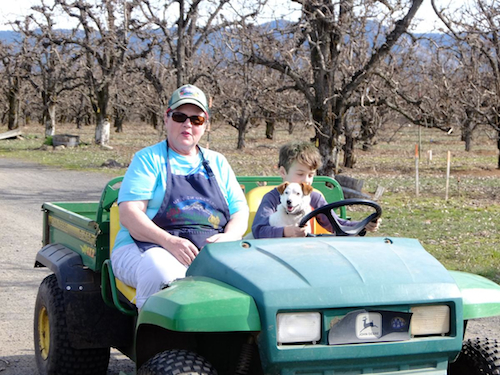 A lovely lady and her grandson I met at the orchard.
A lovely lady and her grandson I met at the orchard.
Her smile was so warm and welcoming, I was instantly taken by her. She is 70 years old, so she doesn't work at the orchard anymore, but she loves driving around the property with her grandson every day. This idyllic scene is also typical of Oregon.
I've digressed. Getting back to topic, the readiness to try new ideas, and the support shown or permits given to these ideas, the "why not give it a try spirit" can also be seen in other areas. Cherishing the old, yet enjoying the new. This may seem contradicting at a glance, but how is the balance maintained? I asked Bob this one last question.
"There's a famous quote from the writer George Santayana,
'Those who don't remember the past, are condemned to repeat it.' Great ideas and opportunity come from being open and willing to examine people and ideas on their merits, rather than 'this is way we've always done it.'
During the 1950's and 60's there was a rush in America (and Portland, too) to devalue the presence of the past; historical buildings, streetcars, furniture, music...other cultural artifacts. We succumbed to the allure of 'the brave new modern world' and suffered through 'urban removal.' In the 1970's we realized that we were treating our cities just like we'd treated our natural resources; cut and remove everything because we can simply plant/build everything new and modern. Portland and Oregon cried out, "STOP," and began the difficult but necessary process of repairing, replanting, and rethinking how to learn and live with nature and our built environment."
目次へ移動 The carpet pattern everyone remembers
"The carpet pattern everyone remembers" that I mentioned in the beginning may represent this sentiment and the people's love for their hometown.
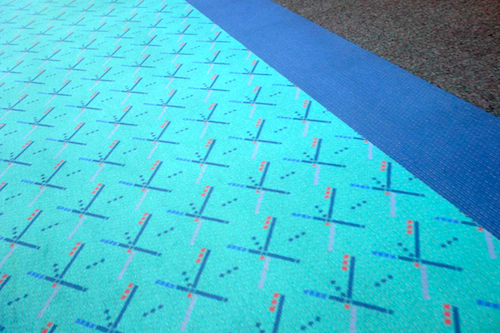
This is the carpet in question. It was designed in the 80s, and every time it needed to be replaced, they recreated the design, but at last, it was replaced by a completely new design. Social media erupted after people heard about this on the news.
"I felt like I had really come home when I saw that carpet. It used to comfort me." "There no other carpet like it in the world." People's love for the carpet spurred a huge movement. Portlandians created beer bottles and T-shirts featuring the carpet design, and some people even got the design tattooed onto their backs. They also created a web shop, too.

It may seem like people weren't taking it seriously, but I think this movement truly reflects Oregonians' values - their love for their home state, their love for the old, and willingness to implement new ideas.
目次へ移動 A new future brought to life by shared values - living in harmony with nature
When you look at the oil shock and The Great Recession on a timeline, they would seem like unfortunate events. But Portland used this opportunity to reexamine its values, to weed out the unnecessary, and rediscover what is truly important. And they came to understand once again that through the ages, nature is their most important asset, what impacts their quality of life the most.
Lastly, let me introduce a pass time that helps nurture Portlanders affinity to nature.
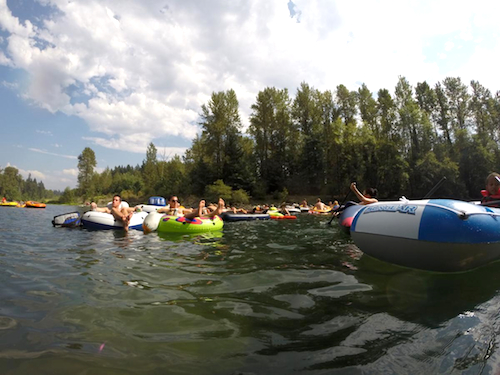 People floating.
People floating.
Many people spontaneously drive out of the city to enjoy "floating" on the slow moving currents of the rivers. They spend 3-4 hours traveling down river floating on a rubber boat letting the currents have their way. When it's crowded the rivers get packed like sardines in a can. Adults and children alike float on the river enjoying the scenery - the forests, mountains, and the sky. It's a pass time that is very Oregonian.
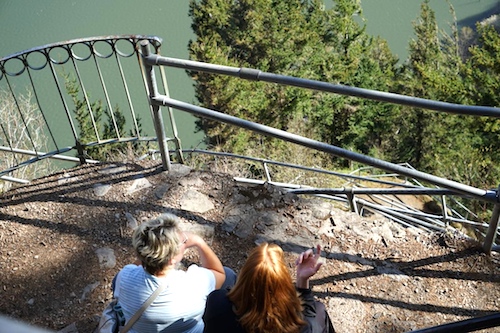 Talking about their problems while looking out at the magnificent view.
Talking about their problems while looking out at the magnificent view.
On the path along the river with a picturesque view that I mentioned earlier, I found 2 elderly women talking to one another while taking in the view. Even in the late afternoons on a weekday, many people congregate in places with a magnificent view. There are also a lot of people who love to run on the trail in the mountains come rain or shine. Of course people enjoy running, cycling, and street sports in the cities, too. In a low-context culture like the U.S., building a reserve of such experiences is an important factor that is helping to build a society with share values, a society that cherishes nature above all else.
Taking on a new challenge while continuing to honor and respect traditions. Never forgetting to appreciate the land. These fundamental characteristics have helped transform economic downturns into opportunities and have enabled Portland to grow. Portland today is the very vision of the kind of future people across the world want. If you ever have a chance to visit Oregon, please experience its forests, rivers, and farms, too. I'm sure you'll discover the secret to Portland's unique atmosphere.
Yuhki Udagawa
President and creative director at BAUM LTD.
In 2010 he established BAUM to help change people's perception and relationships through design. The company mainly works on city development and designs concepts for shops and hotels. Every 2-3 months he visits Portland to help out with projects undertaken by local companies and governments.
Original Japanese text and photographs by: Yuhki Udagawa
Translated by: Yuri Morikawa (oxygen inc.)















